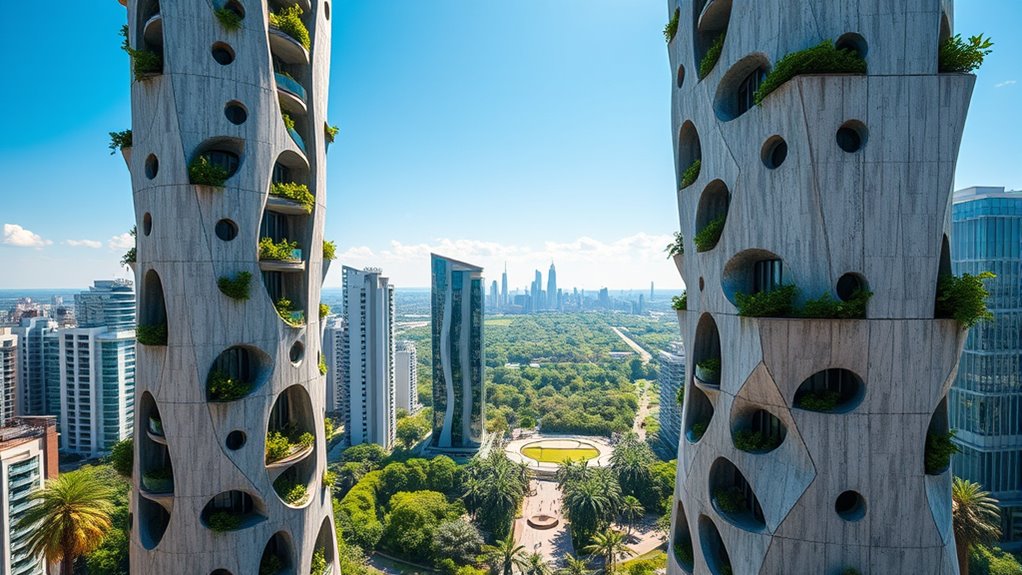Carbon-negative concrete is revolutionizing how you can build greener cities by absorbing more CO₂ than it releases during its lifecycle. By integrating CO₂ capture during curing and using special additives, it turns traditional concrete into a climate solution rather than a problem. This innovative material reduces construction’s carbon footprint and supports sustainable development. If you’re interested in how these materials could shape future urban landscapes, exploring further reveals all the exciting possibilities.
Key Takeaways
- Carbon-negative concrete actively absorbs more CO₂ during its lifecycle than it emits, turning construction materials into carbon sinks.
- It integrates CO₂ capture during curing or with additives, reducing reliance on traditional cement production and lowering overall emissions.
- Using this innovative material significantly diminishes the carbon footprint of urban infrastructure, supporting sustainable city development.
- Made from abundant, low-impact resources, it enhances resource efficiency and promotes circular economy practices in construction.
- Widespread adoption of carbon-negative concrete advances climate goals, helping build resilient, low-carbon, and environmentally friendly cities.

Have you ever wondered if concrete, a major source of carbon emissions, could actually help reduce the planet’s greenhouse gases? It might seem counterintuitive since traditional concrete production contributes heavily to our carbon footprint. But innovative developments are turning this around by creating carbon-negative concrete—materials that absorb more CO₂ than they emit during their lifecycle. This shift is essential because concrete is everywhere, from roads to skyscrapers, and making it sustainable could considerably cut global emissions. By adopting these new types of sustainable materials, you’re helping build a future where construction actively fights climate change instead of fueling it.
Carbon-negative concrete works by integrating processes that capture and store carbon dioxide during the curing process or through the use of special additives that absorb CO₂ from the atmosphere. These techniques transform a material once seen as environmentally harmful into a tool for environmental restoration. The carbon footprint of traditional concrete is large, primarily due to cement production, which involves calcination of limestone releasing vast amounts of CO₂. But with carbon-negative alternatives, the entire lifecycle—from manufacturing to demolition—can be optimized to sequester more carbon than emitted, effectively turning concrete into a carbon sink. Additionally, advances in projector technology are making sustainable construction methods more accessible and efficient.
Carbon-negative concrete captures CO₂ during curing, transforming it into a climate-friendly, environmentally restorative material.
Using such innovative sustainable materials not only reduces your impact but also promotes a circular economy in construction. Instead of contributing to environmental degradation, the concrete you choose can help regenerate ecosystems by removing greenhouse gases from the air. This approach aligns with the broader goal of creating green cities—urban areas that prioritize low emissions, renewable energy, and sustainable infrastructure. When you opt for carbon-negative concrete, you’re supporting a shift toward building with materials that actively mitigate climate change instead of exacerbating it.
Furthermore, these advanced concretes are often made from abundant, low-impact resources, making them more resilient and less resource-intensive. Incorporating carbon-negative concrete into your projects means you’re participating in a movement towards more sustainable construction practices. It’s about rethinking how we build, turning what was once a pollutant into a climate solution. As cities grow and demand for construction materials increases, choosing such innovative options becomes essential for meeting global climate goals. You have the power to influence this change by advocating for and adopting these sustainable materials in your projects, helping to shape resilient, low-carbon urban environments.
In essence, carbon-negative concrete offers a promising pathway to reduce your environmental footprint. It embodies a future where construction supports ecological balance instead of disrupting it. By embracing these new materials, you’re not just building structures—you’re building a sustainable, climate-friendly world for tomorrow.
Frequently Asked Questions
How Does Carbon-Negative Concrete Compare in Cost to Traditional Concrete?
When you compare the cost of carbon-negative concrete to traditional concrete, you’ll find it often costs more upfront due to materials and production methods. However, as market adoption grows and production scales up, costs are gradually decreasing. Over time, the environmental benefits and potential savings from carbon credits or incentives could make carbon-negative concrete more cost-effective, encouraging wider adoption in sustainable construction projects.
What Are the Long-Term Durability Prospects of Carbon-Negative Concrete?
You wonder about the long-term durability of carbon-negative concrete. It’s designed with material longevity and environmental resilience in mind, making it highly durable over decades. Its composition resists cracking, weathering, and environmental stressors better than traditional concrete. This means you can expect it to maintain structural integrity longer, reducing maintenance costs and environmental impact. Overall, carbon-negative concrete offers promising durability prospects that support sustainable, resilient building practices for the future.
Can Carbon-Negative Concrete Be Produced at Scale Globally?
Like a puzzle coming together, scaling carbon-negative concrete faces both challenges and opportunities. You’ll need to overcome scaling challenges and develop robust supply chains to produce it globally. While the technology exists, expanding production requires new infrastructure and standards. With innovations and collaboration, you can turn this eco-friendly material into a widespread solution, helping build greener cities worldwide. It’s a complex process, but achievable with concerted effort and strategic planning.
How Does Carbon-Negative Concrete Impact Urban Heat Island Effects?
You might notice that urban microclimates often intensify heat absorption, making cities hotter. Carbon-negative concrete helps mitigate this by reducing overall heat absorption in buildings and pavements. When you use it, it can lower surface temperatures, which in turn lessens the urban heat island effects. This creates cooler, more comfortable urban environments, helping to combat rising temperatures and improve the quality of city living.
Are There Any Government Incentives for Using Carbon-Negative Concrete?
You should explore government grants and policy initiatives supporting sustainable construction. Many governments now offer incentives for using eco-friendly materials like carbon-negative concrete, aiming to reduce emissions and promote green building practices. These programs often include financial grants, tax credits, or preferential procurement policies. By taking advantage of such incentives, you can lower costs and contribute to environmental goals, making your construction projects more sustainable and aligned with current green policies.
Conclusion
As you embrace carbon-negative concrete, you’re quietly paving the way for a more sustainable future. While it gently whispers of change, this innovative material hints at a world where urban growth and environmental care walk hand in hand. By choosing greener options, you’re helping to craft cities that breathe easier, reflecting a subtle yet profound shift. In doing so, you contribute to a legacy where progress and preservation softly intertwine, shaping a resilient tomorrow.









